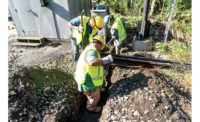With just two days to spare before a year-end implementation deadline, 41 U.S. freight and passenger railroads have met a federal mandate for full deployment of positive train control to prevent potentially deadly crashes.
The Federal Railroad Administration said on Dec. 29, that in addition to being in full compliance with the safety technology's technical requirements on more than 57,500 route miles, the railroads have achieved full interoperability between host and tenant railroads operating on PTC-governed main lines. The group includes New Jersey Transit, which the agency said last month appeared at risk for not meeting the completion target based on earlier data.
The Association of American Railroads says that since 2008, Class 1 railroads invested nearly $11.5 billion to implement PTC. The U.S. Dept. of Transportation provided $3.4 billion in grant and loan funding.
Operated by train and track operators, GPS-based PTC systems combine on-board locomotive and trackside systems to monitor and automatically control train speeds and movements, reducing the risk of human error.
With many railroads adopting customized PTC solutions, the mandate’s interoperability requirement proved to be one of the more complex implementation challenges for major passenger rail operations such as NJ Transit, which shares more than 300 miles of track with five tenant railroads, and also operates trains on Amtrak’s Northeast Corridor.
In September 2016, an NJ Transit train crashed into the Hoboken station, killing one person and injuring more than 100 others. Although the train was traveling at more than twice the 10-mph speed limit, investigators were unable to determine whether PTC might have prevented the crash.
Despite beginning 2018 with only 12% of its PTC program in place and delayed testing on trains with passengers aboard, linked to problems with software provided by contractor Parsons, NJ Transit’s intensive catch-up effort with that firm and Alstom culminated in the federal railroad agency announcing certification of its system on Dec. 18.
Similarly, the Long Island Rail Road overcame early-year delays in software delivery and what the agency called “COVID-19 impacts” to achieve full interoperability with Amtrak’s system in early December, allowing the systems to safely share tracks in a joint service area bordered by complex interlockings at Penn Station and Sunnyside in Queens, N.Y.
Amtrak reported in August that integration of PTC on a one-mile section of slow-speed track in Chicago marked completion of its implementation program. Following a 2015 high-speed derailment in Philadelphia that killed eight people and injured more than 200 others, a Pennsylvania judge determined last May that the engineer in that incident could be held criminally responsible for the deaths and injuries.
Recommended, Then Mandated
Initially recommended by the National Transportation Safety Board more than 50 years ago, and mandated by the 2008 Rail Safety Improvement Act, PTC is now required on more than 40% of the nation’s approximately 140,000-mile railroad network, including Class I freight railroads’ main lines that handle five million or more gross tons of annual traffic, and main lines that support intercity or commuter rail passenger service.
Congress extended the original 2015 PTC implementation deadline by three years in response to railroads’ concerns about the speed and cost of incorporating a technology they asserted was not fully developed.
By the close of 2018, however, only four railroads had successfully met all statutory deployment requirements, including installation of locomotive and wayside equipment and staff training.
The remaining carriers—ranging from BNSF, Norfolk Southern and Amtrak to dozens of intercity carriers and short line/terminal operators—qualified for penalty-free extensions as long as they regularly reported progress toward having PTC in place by the end of 2020.
According to NTSB, more than 150 rail incidents over the past 50 years could have been prevented by some form of automatic speed control and braking technology. The most recent incident, a February 2018 collision between an Amtrak passenger train and stationary CSX freight train in Cayce, S.C., occurred two months after a speeding Amtrak passenger train derailed at a curve along a recently completed alignment in DuPont, Wash.




Post a comment to this article
Report Abusive Comment